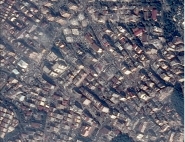Satellite
The main design drivers for the satellite architecture are the image quality, the agility and the image location accuracy. The image quality drives the instrument size. A high agility requires a very compact design, with a few stiff appendages. As a consequence, the instrument is integrated inside the bus. A high image location accuracy is achieved by minimizing the interface between the instrument and the bus. The star trackers and the gyroscope heads are directly supported by the instrument to avoid any thermal distortion that could be induced by the bus.
The bus structure is built on a hexagonal shape, with three solar arrays at 120 degrees, and three star trackers in a quasi tetrahedron configuration, optimizing the attitude determination accuracy. This configuration authorizes accommodation of the instrument focal plane radiator for maximum heat dissipation. An antenna support structure is used to carry the Earth-pointing antennas and for the instrument baffle.
The solar arrays are mounted directly on the bus structure without any drive mechanism to ensure a maximum stability. Their first flexion mode frequency is increased by the use of stiffeners when deployed. Moreover, the high compactness and low mass of the satellite (<1000 kg) make it compatible with a large series of low cost small launchers (among them Soyuz and Rockot). The two Pleiades satellites will be launched by Soyuz from Europe's spaceport in Kourou, French Guiana.
